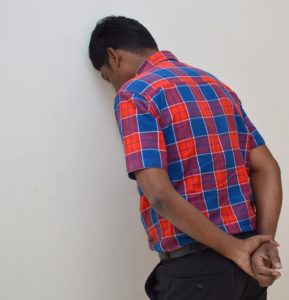A pathbreaking new study out of Finland suggests that early intervention programs for youth experiencing psychotic-like symptoms may see the greatest improvement when treatment works within the home rather than in a hospital setting. The research, to be published in next month’s issue of Psychiatry Research, found greater improvement in functioning, depression, and hopelessness among teens in a new need-adapted Family and Community oriented Integrative Treatment Model (FCTM) program.
 “The improved ability to function observed in the network-centered early intervention group is crucial since this is usually a major challenge for people with psychotic-like symptoms,” lead author Docent Niklas Granö told PsychCentral.
“The improved ability to function observed in the network-centered early intervention group is crucial since this is usually a major challenge for people with psychotic-like symptoms,” lead author Docent Niklas Granö told PsychCentral.
“When young people receive real support with things that weigh on them and cause them stress, their mood lightens, their ability to function improves, feelings of hopelessness wane, and their recovery speeds up.”
Previous studies have shown the early intervention for young people experiencing their first episode of psychosis can significantly improve long-term outcomes. However, there is currently not enough research to determine which early-intervention models might be most useful. Meta-analyses of different early intervention strategies (including antipsychotics, therapies, omega 3s and alternative supplements) suggest that therapy reduces the risk of a transition to psychosis compared to standard pharmacological treatment.
This study also draws on research into the role of the family and the home environment in adolescents treatments for psychosis. “The emotional atmosphere in the family environment, parental attitudes, behaviour, and coping strategies are associated with functional outcomes and symptom expression in at-risk adolescents,” the researchers write.
Drawing on this body of work, the study authors developed the hypothesis that “stress-reducing care carried out in cooperation with family members in the community (schools, home) and with multi- disciplinary workers from the community may have a stronger positive effect on the level of psychiatric symptoms and effectively supports functioning in help-seeking adolescents.” Teens in the FCTM intervention would first be contacted by a community professional, like a school nurse or counselor, who was already a presence in the adolescent’s life.
The study randomized fifty-six young people, deemed clinically high risk for psychosis, into two groups. Twenty-eight participants received treatment as usual (TAU) at a hospital, and twenty-eight participants were placed in an experimental, home-based program. The groups did not differ on clinical measures at the beginning of the trial but after one year those in the experimental groups showed significantly better improvement.
Young people in the need-adapted Family and Community Oriented Integrative Treatment group had greater improvements in functioning (20% vs. 6%), depression (53% vs. 14% ) and hopelessness (41% vs. 3%), compared to those receiving treatment as usual.
“In the present study among subjects who had psychosis-risk symptoms, we found greater improvement in functioning and level of self-reported depression and hopelessness in adolescents who received need-adapted, Family- and Community-orientated integrative treatment instead of standard adolescent psychiatric treatment,” the researchers conclude. “Our findings highlight the importance of grounding and networking in the psychiatric care of adolescents.”
More:
PsychCentral: Early, Home-Based Treatment Best for Teens with Psychotic-Like Symptoms
*
Granö, N., Karjalainen, M., Ranta, K., Lindgren, M., Roine, M., & Therman, S. (2016). Community-oriented family-based intervention superior to standard treatment in improving depression, hopelessness and functioning among adolescents with any psychosis-risk symptoms. Psychiatry Research. (Abstract)















These data don’t reflect only “greater improvement,” they reflect dramatically greater improvement, particularly in “hopelessness” (41% vs. 3%), better by a factor of 14! I’m kind of surprised (though perhaps I should not be) that their conclusions are so muted given the results. If any actual MEDICAL intervention showed a 14x greater chance of significant improvement over TAU, it would most likely be immediately proposed as the new standard of care. Yet this is published in some journal and will be forgotten within days or never read by most psychiatrists. This should be BIG NEWS!
Report comment
“When young people receive real support with things that weigh on them and cause them stress, their mood lightens, their ability to function improves, feelings of hopelessness wane, and their recovery speeds up.”
Call me old fashioned, but when anyone is offered real support with things that wiegh on them and cause them stress, thier mood lightens, thier ability to function improves, feelings of hopelessness wane……
I’m not dissing the programme, I am questioning the whole idea of mental illness
Report comment
I agree 100 per cent John.
Report comment
Mental distress is reduced when painfully distressful experiences are addressed with support compared to forced drugging and imprisonment in a mental institution; who’d a thought?
Report comment
Yeah, kind of a no-brainer, isn’t it? “Which would you prefer, to be treated as a malfunctioning ‘unit’ that needs to be tinkered with and ‘fixed’ by ‘professionals’, or to have someone provide support for things that weigh on you and cause you stress?” I wonder what percentage of people would select the first option?
— Steve
Report comment
This news will be avoided because making people well is not profitable.
Report comment
Good focus Steve; 1400% improvement should demand more attention!
Best wishes, Steve
Report comment
Is FCTM basically the same thing as Open Dialog? And this should be BIG NEWS, since it’s based upon
a meta – analyses, and meta – analyses are the “gold standard” in research, right?
“Meta-analyses of different early intervention strategies (including antipsychotics, therapies, omega 3s and alternative supplements) suggest that therapy reduces the risk of a transition to psychosis compared to standard pharmacological treatment.” This is likely because today’s recommended pharmacological treatments, like today’s “bipolar” cocktail recommendations and the “schizophrenia” drugs, are both known to create “psychosis,” via anticholinergic toxidrome.
As to the huge changes in “hopelessness (41% vs. 3%),” this may relate to the fact that the therapist is trying to address the child’s real problems, within their real life setting. Rather than doing what the psychiatric industry has been doing for the past several decades. Which is ignoring the person’s real life problems, picking out a DSM diagnoses, then “educating” the person about their hopeless new, “life long, incurable, genetic mental illnesses,” and then creating the symptoms of the “disease” with the psychiatric drugs. By the way, the bio-psychiatric approach is also called gas-lighting a person, and gas-lighting a person is “mental abuse,” not medical care.
Just curious, how can “studies” prove “early intervention for young people experiencing their first episode of psychosis can significantly improve long-term outcomes,” if “there is currently not enough research to determine which early-intervention models might be most useful?” I’d be curious to see these studies.
Report comment
Yeah, seriously, if you weren’t depressed before you got the “psychiatric explanation,” you should would be afterwords!
Report comment
There aren’t mental illnesses, but there are plenty of physical illnesses that cause “mental” symptoms, some that are actually occurring far from the brain (think sugar blues, for example).
I’d also be interested in what kind of supplements the parents that did use them were using. With the proper ones and a junk-free diet the parents could kick the hospital’s butt for recoveries.
Report comment
Twenty-eight participants received treatment as usual (TAU) at a hospital…
TAU – Door locked, cell phone containing number to friends and family confiscated , strip search standing naked bare feet on the hospital floor to be viewed by strangers… Reactions to this prison camp style dehumanization charted as “agitation” and another symptom of the “illness” before the inevitable shuffle and drool pill lobotomy after the 10 minute interview they bill an hour for. Any refusal of the pill lobotomy met with scary threats of injection and state hospital. Reactions to these scary threats charted as “agitation” and the symptom of the “illness” again.
The latest “treatment as usual” No smoking, reactions to this charted as anxiety and agitation and symptoms of the “illness” again. But you can have one of those stupid nicotine patches that most of the time don’t even help mentally well people not in a crisis trying to quit cause they want to .
Sucks for those 28 people.
Report comment
Maybe “TAU” should be renamed “Torture As Usual.”
Report comment
LOL ! but yes.
I had a friend inpatient totally hating having a cameras pointed at him all the time , almost perfect torture for a paranoid person , and was just terrified the whole time with all the staff assaults on patients and violence going on then going to the phones begging family to get him out and being told he needs to stay to get “help” ! How can you do this to me ???!!!
That dude got his world rocked. Nothing like locking a person up in an environment of surveillance cameras and violence during paranoid psychosis to “help” them.
“Torture As Usual.” Perfect.
Report comment
And his reaction was of course regarded as more “symptoms,” because any sane person would simply accept the bizarre environment of locked wards, beds with leather restraints, cameras everywhere, and nurses and doctors writing notes about you that you can’t read in a private room you can’t access.
The final nail in the coffin of my inability to work within the system for reform was my first visit to a psych ward. I’d rather have spent time in jail than there – at least in jail, they’re being honest about what they’re up to. I can’t see how anything remotely related to healing could have happened in that place!
—- Steve
Report comment